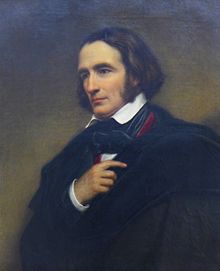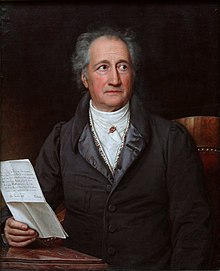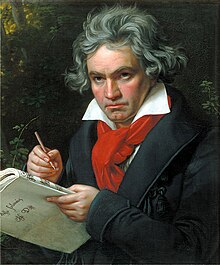Joseph Karl Stieler

Joseph Karl Stieler (born November 1, 1781 in Mainz , † April 9, 1858 in Munich ) was a German painter and court painter to the Bavarian kings from 1820 to 1855. The most important works of Joseph Stieler include the world-famous gallery of beauties of King Ludwig I of Bavaria as well as other high-ranking members of the ruling houses of Europe and the intellectual and creative "nobility" such as Goethe , Schiller , Beethoven and Alexander von Humboldt .
Stieler's oeuvre includes over 500 portraits , which are characterized by high technical ability and a clear idealizing tendency. His style of representation developed based on the baroque miniature, received its special character from the classicism of the French school and finally included early realistic elements in the older work.
Life and career


Joseph Stieler was the son of August Friedrich Stieler, die cutter for the electoral mint in Mainz, and his wife Philippine (née Fritzmann). In the family, whose roots can be traced back to the 16th century, artistic professions - including engraver, stamp and coat of arms cutter or seal engraver - had a tradition. Joseph also received drawing lessons from his father at an early age and soon surpassed his older brothers artistically. The early death of his father in 1789 left the family impoverished and in a difficult situation, and prompted the boy to pursue his artistic training independently. He successfully continued drawing and acquired the art of miniature painting without personal guidance - probably with the help of one of the textbooks popular at the time. A great open-mindedness for new artistic impulses, a careful but also efficient way of working as well as the connection to the upscale and courtly society shaped his further life as a painter.
A miniature of his sister for her fiancé drew his attention to Stieler's talent. This marked the beginning of his more intensive preoccupation with art and brought in further commissions through which he could increasingly support his family. He also benefited from the increased need of broader bourgeois circles for portraits.
As a teenager he decided to follow the court camp of the escaped baron Friedrich Karl Joseph von Erthal to Aschaffenburg , where he was welcomed and found numerous opportunities to work as a miniature painter. There he got to know Baron Karl Theodor von Dalberg , with whom he remained in close contact from then on, and who supported him ideally and practically.
After creating a certain foundation for himself, he took up a two-year apprenticeship with Johann Christoph Fesel in 1798 , where he learned how to use oil paints . Around 1802 he studied - Stieler's first systematic artistic training - at the KK Akademie der Künste in Vienna under the direction of Heinrich Füger , from whom he, among other things, accepted the advice to give up miniature painting in favor of larger works. He graduated there successfully in 1805. Stieler then went on a work trip to Russia , but had to stay in Poland due to the war between Napoleonic France, of which he was a national, and Russia , where he received numerous orders. From there he returned to Vienna in 1807. Travel played an important role in Stieler's artistic life. In the same year he finally went to Paris for a year and a half , where he benefited from numerous social contacts and the city's rich cultural offerings. Here he also studied - especially with François Gérard - for the second time and took up formative classical influences that meant a new beginning for his work. During this time an unspecified eye disease also fell , which at times made the painter fear at least for his artistic existence, so that he had to spend some time inactive and in deep despair before the ailment fortunately subsided.
Further work stays in Frankfurt am Main and Italy followed. During Stieler's stay in Italy from 1809 to 1812, he came to Milan, where he made the acquaintance of the Viceroy of Italy, Eugène de Beauharnais . Stieler's wife, Auguste von Bayern , commissioned him to portray their children in order to send them to their parents in Munich. There they evoked enthusiasm. In the period that followed, the couple commissioned further family pictures. This precious collection was inherited by their son Maximilian von Leuchtenberg , who moved it from Munich to Saint Petersburg shortly before his death.
In 1812, Stieler arrived in Munich from Italy and worked for King Max I Joseph . On December 18, 1820, he appointed him by decree as a Bavarian court painter, initially without a salary. When the previous court painter Matthias Klotz died two years later, Stieler received an annual salary of 1,000 guilders. In addition, he was allowed to take vacations and other assignments.
As an established portraitist, Stieler created a large number of paintings, including a considerable number of family portraits of the royal family and his personal ties to the ruling house. In 1821, after the death of her youngest daughter "Ni" , Queen Karoline had a last large painting and several portraits of the little princess on her death bed made and last consolation pictures on her death bed after the sudden death of her husband Max I. Joseph.
In 1818 Stieler married his great love, Pauline Luise Beckers of Russian descent, and had a happy marriage with her. Her early death in 1830 hit the painter hard; In 1833 he married the poet Josephine von Miller - in a second, equally happy marriage - without completely overcoming the loss.
Commissioned by Antonie Brentano in 1820 - under difficult conditions - he created what is now the most famous portrait of Ludwig van Beethoven . His famous portrait of Goethe was created in 1828 in lively exchange with the poet and scholar . In 1823 he was one of the founding members of the Munich Art Association .
In the years around 1830, which were difficult for Stieler personally, numerous works and trips followed. In 1848 the painter was confronted with the political upheaval in Bavaria, the events surrounding Lola Montez , whom he reluctantly portrayed, and the abdication of King Ludwig I of Bavaria . In the forties, too, numerous pictures were still created, whereby Stieler increasingly had to deal with the politically and artistically changed environment and was productive, but already as an aging painter, looking for new ways. He emphasizes the importance of the new and is open to both landscape painting and the emerging photography .
In 1854, Stieler carried out his last major orders. These include a group portrait of the siblings of Empress Elisabeth (Sisi) on the occasion of their wedding to Emperor Franz I Joseph and five portraits of baronesses commissioned by Prince Karl of Bavaria .
In 1855 he retired as a court painter at his own request and spent a few more years in his summer house in Tegernsee , today's Stieler house. In 1858 he finally died of pneumonia and paralysis. His extensive work has now met with divided echoes. Some of his descendants, including his son from his second marriage to the poet Josephine von Miller, the poet Karl Stieler (1842–1885), were to take up artistic professions.
Work and style
Joseph Stieler mainly created portraits . There are also a number of altarpieces as well as a few pictures with narrative, often mythological motifs and - in the private estate, independent of outside orders - a largely independent work of drawings.
His paintings are characterized by a high level of technical perfection, safe, clean drawing and a noticeable smoothness that sometimes already looks cool. This corresponds to a pronounced tendency to idealize the carefully arranged portraits.
In dealing with light, composition and painting style, Stieler's work is initially based strongly on baroque miniatures and rigid technical regulations, continues to develop - on classicist influences from France and finally even takes on early realistic elements and suggestions from the now independently established landscape painting, the At the beginning of the 19th century it was contemptuously dismissed as "moss or lichen on the trunk of great art": The space depicted in the pictures is now made more real, the portrayed are shown more and more human as individual personalities. The painted landscape emerges from its function as a mere addition and background.
However, regardless of the strict and representative conceptions of classicist models, as a person and artist, Stieler was able to respond sensitively to his models and to adapt his representation to the peculiarities of the sitter and the social context of the picture, which in many cases gives the portraits a more pronounced, livelier character .
The private graphic work, which also illustrates his stylistic development, also expresses a far more individual way of seeing and drawing; However, studies on this are very difficult today due to the incomplete tradition.
Effect and criticism

Joseph Stieler was a successful and in his time very famous portrait painter, who went down in art history in particular through his work for the Bavarian and Prussian royal houses as well as numerous other regents and important personalities.
The contemporary Allgemeine Deutsche Biographie judges this from a short distance for the period around 1820 as follows: “Now [Stieler] became 'fashion' in the haute volée and it was good form to let [him] disobey you. Countless portraits of statesmen, military leaders, scholars, artists (including, for example, Prince Wrede , General von Pappenheim), of illustrious and high-ranking women, most of whom still belonged to the reign of King Max I. "
Later epochs often criticized his idealizing method of representation and his conception of the portrait, which seemed to them to be too "traditional" for their own claims, but did not question his technical ability as a painter. Accordingly, towards the end of his career, Stieler himself recognized the importance of change. However, this critical examination is often only based on a relatively small, publicly accessible part of the work.
With an increasing time lag, a differentiated criticism takes the place of general evaluations and attempts at delimitation, but the work and the painter only meet with well-founded interest to a limited extent. Further research is also made difficult by the difficult tradition and especially the extensive distribution of the plant locations.
Nevertheless, the painter's most comprehensive catalog raisonné to date was published as part of the dissertation by the Stieler researcher Ulrike von Hase. Since then, a large number of other works have become known that have not yet been presented to the public. The researcher also has relevant further material.
Places of remembrance of Karl Joseph Stieler
In contrast to Stieler's noble Munich home built in 1841 at Barer Strasse 6 1/2, his summer house in Tegernsee has been preserved as a place of remembrance . The artist had acquired the property on Tegernseer Point in 1829 for 159 guilders and 54 cruisers. In the period that followed, a comfortably furnished house was built for the summer vacation, with a studio not missing. After a loving restoration, it has housed a café since 2015.
Above the Stieler house, on the literary hill on Leeberg, a monument with his bust commemorates Karl Joseph Stieler.
The artist's grave is located in the Old Southern Cemetery in Munich (left wall, place 248/249 near grave field 11; location ).
literature
- Ulrike von Hase: Joseph Stieler 1781–1858: His life and work. Critical list of works. Prestel-Verlag, Munich 1971, ISBN 3-7913-0340-6 .
- Gerhard Hojer: The beauty gallery of King Ludwig I. 4th edition. Schnell and Steiner, Regensburg 1997.
- Hyacinth Holland : Stieler, Joseph . In: Allgemeine Deutsche Biographie (ADB). Volume 36, Duncker & Humblot, Leipzig 1893, pp. 189-196.
- Tino Mager: Stieler, Joseph Karl , in: Savoy, Bénédicte and Nerlich, France (ed.): Paris apprenticeship years. A lexicon for training German painters in the French capital . Volume 1: 1793-1843, Berlin / Boston 2013, pp. 278-281.
- Dorothea Minkels : Elisabeth of Prussia, Queen in the time of March. BoD, Norderstedt 2008, ISBN 978-3-8370-1250-7 .
- Karl Alexander von Müller : The court painter Joseph Stieler. In: Unknown Bavaria: Portraits from eight centuries . Süddeutscher Verlag, reprint 1976, ISBN 3-7991-5839-1 .
- Sonja Still: Joseph Stieler. The royal Bavarian court painter. Munich 2020, ISBN 978-3-96233-194-8 .
- Constantin von Wurzbach : Stieler, Joseph . In: Biographisches Lexikon des Kaiserthums Oesterreich . 38th part. Imperial-Royal Court and State Printing Office, Vienna 1879, p. 350 f. ( Digitized version ).
Web links
- Literature by and about Joseph Karl Stieler in the catalog of the German National Library
- Goethezeitportal: Stieler's portrait of Goethe and its adaptations (J.Assel, G. Jäger)
- Beethoven digital: Stieler's Beethoven portrait and the accompanying oil study
Individual evidence
- ↑ On the ancestry of the artist family cf. Dr. U.v. Hase (1971), p. 12 as well as that of Dr. Lindner (1926) created the family tree.
- ↑ On the painter's career, see the first chapter in biography in the standard work of Dr. U.v. Hases (1971) and H. Holland (ADB 36: 1893) and G. Hojer (1997) as indicated.
| personal data | |
|---|---|
| SURNAME | Stieler, Joseph Karl |
| BRIEF DESCRIPTION | German painter |
| DATE OF BIRTH | November 1, 1781 |
| PLACE OF BIRTH | Mainz |
| DATE OF DEATH | April 9, 1858 |
| Place of death | Munich |



